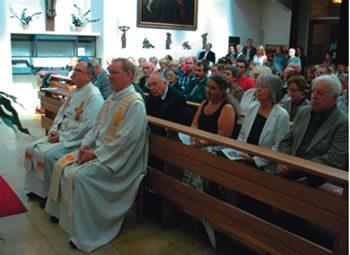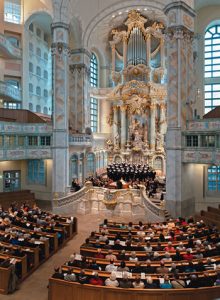Reflections on the Church in Germany
When I saw the article ‘Prayerful Churches: Berlin to Remember’ by Glen McCullough in the February Messenger, I was pleased to see some pictures of churches in Berlin. I was astounded to read, though, that he was told that ‘only 2% of Germans attend church.’
Being German and having emigrated only five years ago, I couldn’t believe this figure, and wondered what it was based on.
(Ed - Glen remembers hearing it from the commentary on a Hop-On-Hop-Off bus around East Berlin.)
Maybe it is best to look at the background of Christians and ‘church attendance’ in Germany. As it says ‘church’ attendance, this figure includes only the Christians. According to the census of 2011 there are about 81.1 million inhabitants in Germany. 74 million of them (92.3%) were of German nationality.
Church statistics, from the German Bishops’ Conference website (www.dbk.de), show that there are 23.9 million Catholics and 23.0 million Lutherans in the country. In addition, there are about 24.9 million Christians of other denominations. Therefore, about two-thirds of the population is registered as Christian.
In Germany, the members of the Catholic and Lutheran congregations pay so-called ‘Church Tax.’ The Church Tax is about 8-9% of the annual income tax a person pays to the Tax Office. As those people with low wages or unemployed are exempt from taxes they don’t pay Church tax either. This system makes it easy for the Churches to see how many members they have. Every Catholic or Lutheran is registered.
Being ‘registered’ as a member of a Congregation doesn’t mean that this member attends church services. Some people only go to Mass for certain occasions, as happens all around the world.
There are two more factors that I think are important to consider when you look at Germans attending church services.
The first factor is that about one third of German Christians are Lutherans. According to the traditions of the Lutheran Church, regular attendance at church services is not an obligation. It is an offer and an invitation.
The second factor is the huge impact that dictatorships had on the Church, especially the regime of the former German Democratic Republic (GDR, often called ‘East-Germany’). During the 40 years of Socialist Dictatorship, being a member of a Church meant being a second class citizen. If a person openly practised a religion, this person and often family members of that person had to accept disadvantages in many ways. You had to be courageous to be a practising Christian, and I have deep respect for those who kept their faith, despite all the odds. I met some of these Christians who met secretly for prayers and liturgies of the Word. I know priests who had to ask relatives from West Germany to smuggle prayer books into the GDR. The Catholics had no hope that they would ever be able to visit Rome or any other pilgrimage place in the world.
Forty years of Socialist Dictatorship after 12 years of Nazi Dictatorship – 52 years of repression for believers. It takes courage for the first generation not to give up and it is difficult to pass the faith on to the next generation. It is also a huge step to change from a strictly authoritarian system to freedom and free choices.
Even today the former GDR is predominantly atheist - despite many baptisms during these last 25 years since the reunification of West Germany and the GDR.
So, what about the almost 24 million Roman Catholics in Germany? The Catholic Church is one of the biggest employers in the country and the Church estimates that there are about 600,000 people who volunteer in the Church. In August 2014, 50,000 altar boys and girls participated in a pilgrimage to Rome and met with Pope Francis. There are many Catholic events during the year with the 2016 “Katholikentag” (a Conference and exhibition of Catholic organisations and groups) celebrating 100 years since it was initiated in the middle of World War I.
Also, Catholic kindergartens and schools as well as Catholic aged-care facilities are very popular.
However, the attendance of massgoers is dropping. In 2014 the average number of Catholics attending Mass across the 27 dioceses was 10.9%. In some parts of the country the figure reached 20% but unfortunately, there have been some regions where the Church has lost ground.
Reasons for leaving the Church include the sexual abuse scandals or the scandal around the bishop who built himself a palace – or simply not wanting to pay the Church tax. It might have been the case in the past but today it is certainly not possible to attract people to Church out of mere obligation.
Fr Alois Greiler sm has experienced the changes in Mass attendance within the last forty years. Having been ordained 27 years ago, he agrees that today’s generation is different. The Faith has become more private and less attached to Churches. The Faith is still there but not so much the institutionalised Church-connected Faith. He points out that ‘Community means today that we meet the people not only in the space of a Church but foremost in other spaces – circles, activities, in residential areas, as a specific age group … a ‘come here’ Church is becoming a ‘go there’ Church.’



 Entries(RSS)
Entries(RSS)